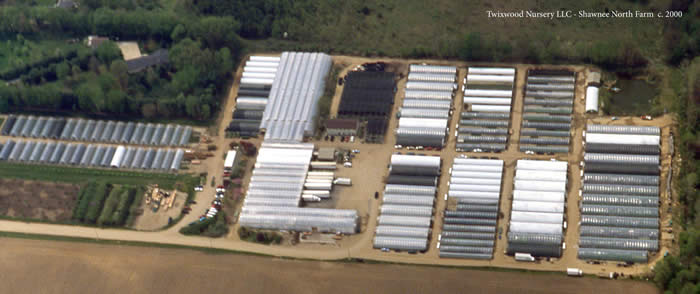This is the second ever nursery blog. We are still trying to figure out what it is and why. We think it has something to do with a lot of words with the words being something that tells a story. The story today has to do with winter production of plants here at the nursery.
Every business has its own personality, which is more or less a reflection of the personality of the owner. Some years ago, and during one of our periodic interactions with management consultants, we barely survived, we were all given personality tests. You will be spared the more sordid details in order to mention that I get great psychic gratification from making things, producing things, cranking out lots of somethings. The previous management team did not suffer from this particular obsession, thus they preferred to purchase just-in-time plugs to pot up into #1 containers. I like to plant things in the field in long straight rows and then to dig them in the fall, heel them in, divide and pot up in the winter, and force in the early spring under poly.
There are several implications to this business model. To begin with it is very complex because it involves getting organized several years in advance getting in new stock plants and making enough plugs to field plant, then grow for two years, and then to propagate into our own plugs. Luck is the predominant factor because guessing what the market wants three years in advance is tricky. All of this thinking provides lots of intellectual activity, not to mention several opportunities along the way to engage in positive thinking. Almost all of the plants that we grow in the field propagate best in the middle of winter when they are dormant with another benefit of mid-winter propagation being the providing of year-around work for our excellent, skilled, trained, and stable work force.
Grasses are a good example of winter work. We have found that if grasses are dug in the middle of summer, divided in the heat of the day, left around for a few minutes to be kissed by the sun and wafted by the breeze, they will be dead within ten minutes. Things go much better in the winter. We do several pennisetums (fountain grass). It is interesting that they are getting shorter, or, more precisely, the market is demanding shorter ones. Originally there was P. alopecuroides and next there was P. a. ‘Hameln’ which was about 6 inches shorter, maybe only 4 inches, whatever, and now everyone wants ‘Little Bunny’ which is listed in our price list as being 12-18”. What I really want to sell is P. a. ‘Piglet’ PP# 21,917, an Intrinsic introduction. ‘Piglet’ is listed in our catalog at 9-18” and I always thought it was a little larger than ‘Little Bunny’, whatever. There are perceptions, there is reality, and there is what we list as accurate information in our price list. When anyone figures it all out let me know.
Speaking of Intrinsic; this is Brent Horvath’s nursery up at the northern edge of Illinois. Brent has spent much of his life working for a living and now he has discovered plant breeding and the patenting thereof and he prefers that to working. We are growing three of his Big Bluestems. These are the ones that are reddish or blackish or purplish. These are the ‘Red October’ (PP#26,283) and the ‘Indian Warrior’ (PP#24,999) and the ‘Black Hawks’ (PPAF). These Andropogons (Turkey Foot in the vernacular) are all nice and dark colored and of significant ornamental value. Some people can tell them apart. We have lots of them except for ‘Black Hawks’. This is named after some professional hockey team or the other and is the hot one, which means, of course, that we are just now building up our stock in it.
Brent has also patented a blue fescue. It appears that everyone has a blue fescue named selection out there. Brent’s is ‘Cool As Ice’ (PP#27,651) and it really is different and better and distinctive. Brent even selected a Little Bluestem that he was too broke that year to patent. Therefore we have lots of it now—‘Jazz’, which is shorter than most Little Bluestems. It is shorter and upright in contrast to my favorite, ‘The Blues’, which is not patented, has a really good color, and any time it is near rich soil or some water in the summer it lodges. We think that this falling over gives it a nice wild natural look. Besides, we have plenty of it.
But I got lost in the details. In the winter we do geranium clump divisions, dormant stem cuttings, root cuttings, and after some forcing, regular stem cuttings; it is a nodal rooter. The main geranium we are working on, to the tune of 20,000 liners, is ‘Max Frei’. This is a nice dark green lower one with lots of gaudy shocking pink blooms. Besides being gaudy it sells well. If we do not get enough liners propagated in the winter then we can pull off some side shoots from our thousands of feet of field grown material come April. We have discovered that geraniums like to be propagated when it is cool. Actually, we have discovered this several times. Now we are starting to believe it. Speaking of dormant stem cuttings, there were some communication issues and we now have 10,000 too many really nice plugs of Geranium ‘Biokova’. These are in a 38 cell pak tray. We are still discussing who to blame for the communication issues. If someone will purchase these plugs then peace and goodwill will be restored here at the nursery and we can quit the discussing. Actually, that may not be true. The person who made all of these plugs might then start to crow about it and take full credit for guessing right and then the whole cycle will start all over again.
And so that is what we are doing this winter—working and discussing and making wild guesses about the future always keeping in mind what Yogi Berra said about making predictions about the future. Incidentally, it is not too late to go out in the field, kick a little snow around and pull up some Geranium ‘Bevans’ cuttings. We have some extra heated bench space. I was planning on making one million plugs of Carex pensylvanica until I was talked into doing only half a million. Carex is another really good cool weather grower which means that it is really bad to propagate in hot weather.
And so as this blog develops, we will be watching carefully to see how it goes. As my friend Otto says about giving eulogies at funerals, you should tell the truth but not all of the truth. That, then, is what we are going to attempt to do here. The theory is that if we describe and tell what kinds of work we are doing each week, then the reader/customer will conclude that we are always thinking and conceptualizing and trying. Then, they will conclude that we are going to have a dynamic business far into the future.

